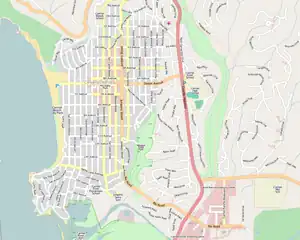| Fee Building | |
|---|---|
 Fee Building on Ocean Avenue. | |
| Location | Carmel-by-the-Sea, California, US |
| Coordinates | 36°33′18″N 121°55′22″W / 36.55500°N 121.92278°W |
| Built | 1935 |
| Built by | Michael J. Murphy |
| Built for | William P. Fee |
| Original use | mixed-use retail shop and residence |
| Current use | Retail |
| Architect | Michael J. Murphy |
| Architectural style(s) | Spanish Colonial Revival architecture |
 Fee Building Fee Building | |
The Fee Building, is a historic commercial building in Carmel-by-the-Sea, California. It was built and designed in 1935, by master builder Michael J. Murphy as a mixed-use retail shop and residence. It is an example of a Spanish Colonial Revival architecture style building. The structure is recognized as an important commercial building in the city's Downtown Conservation District Historic Property Survey, and was nominated and submitted to the California Register of Historical Resources on February 21, 2003.[1]
History

The Fee Building was established for owner William P. Fee, in 1935 as a mixed-use retail shop and residence, located on Ocean Avenue and Lincoln Street in Carmel-by-the-Sea, California, next to the Harrison Memorial Library. The construction cost in 1935 was $8,000 (equivalent to $170,757 in 2022). It is a two-story wood-frame, concrete, stucco Spanish Colonial-style building with an intersecting Spanish tiled roof. The ground level on Ocean Avenue has an arched entrance and shop windows for a retail business. The upstairs apartment has multi-pane French doors that leads to the living room, and an open terrace with wrought iron railings. There are two chimneys that can be seen from the upstair apartment and copper gutters and downspouts.[1][2]
M. J. Murphy, Inc. designed and constructed the Fee Building and J. Weaver Kitchen did the original modern plumbing and fixtures that was part of the construction. Jack Belvail & Sons did the lighting and electrical work for the new property. Major W. J. Hairs reopened the Merle's Treasure Chest in 1936, with jewelry and antiques collected from his travels. Another tenant was Joe's Taxi Service, which had a fleet of Packard cars, and Paul's Barber shop.[3][4]
Several additions and remodeling’s took place over the years. In 1940, the upstairs rear addition was designed by Robert R. Jones for $750 (equivalent to $15,666 in 2022). In 1944, Hugh W. Comstock remodeled the front with glass windows for $242 (equivalent to $4,023 in 2022). In 1957, the interior portion was changed by J. B. Pratessa for $4000 (equivalent to $41,678 in 2022).[1]
The building qualified for inclusion in the city's Downtown Conservation District Historic Property Survey, and has been nominated and submitted to the California Register of Historical Resources on February 21, 2003. The property is significant under the California Register criterion 3, in the area of architecture as an example of Spanish Colonial Revival style and designed by master builder Michael J. Murphy. Developer Samuel Finley Brown Morse made use of this style for houses built in Pebble Beach, California, and the style was used in downtown Carmel in the late 1920s and 1930s.[1][2]
See also
References
- 1 2 3 4 Richard N. Janick (February 21, 2003). "Department Of Parks And Recreation" (PDF). National Park Service. Retrieved June 13, 2022.
- 1 2 Dramov, Alissandra (2019). Historic Buildings of Downtown Carmel-by-the-Sea. Carmel-by-the-Sea, California: Arcadia Publishing. p. 86. ISBN 9781467103039. Retrieved 2022-06-13.
- ↑ "Fee Building Carmel's Newest Business House". Carmel Pine Cone. Carmel-by-the-Sea, California. 1936-03-20. pp. 8–9. Retrieved 2022-06-13.
- ↑ Hale, Sharron Lee (1980). A Tribute to Yesterday: The History of Carmel, Carmel Valley, Big Sur, Point Lobos, Carmelite Monastery, and Los Burros. Santa Cruz, California: Valley Publishers. p. 186. ISBN 9780913548738. Retrieved 2022-06-13.